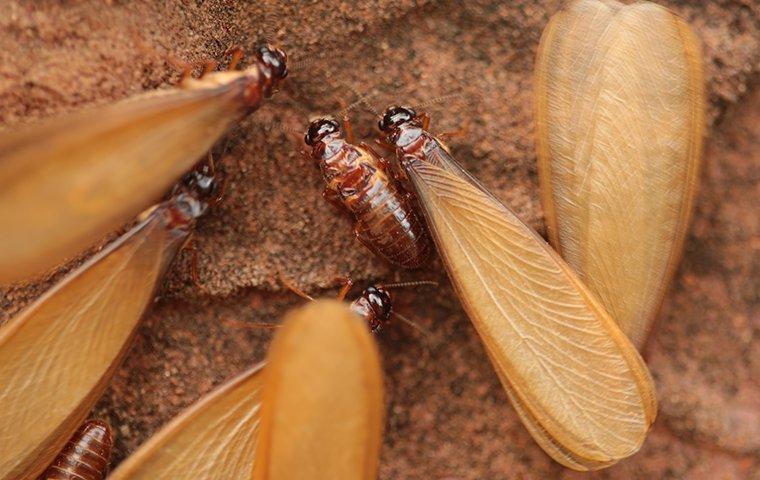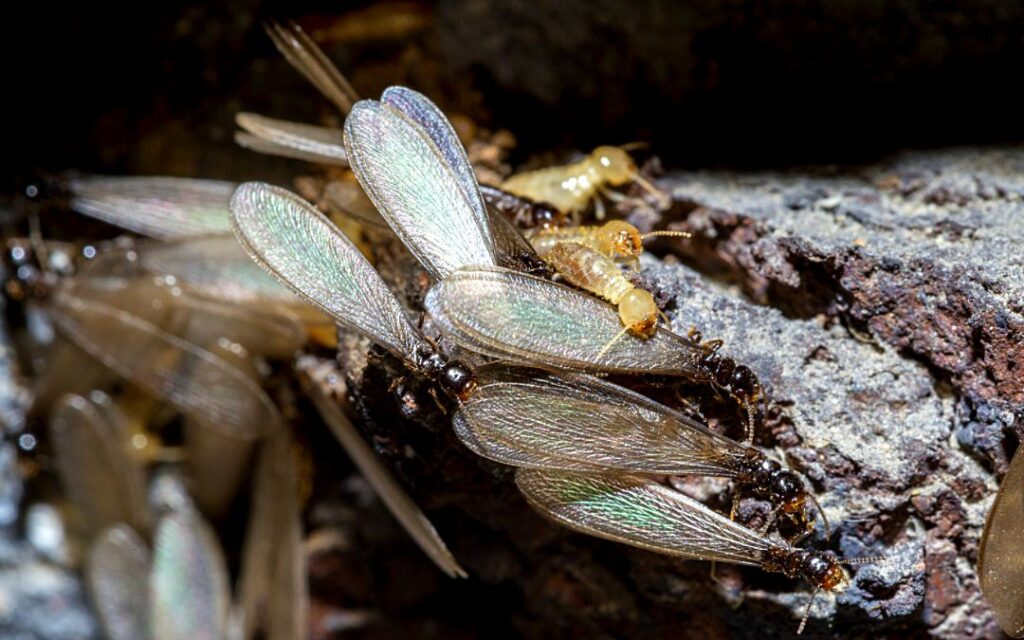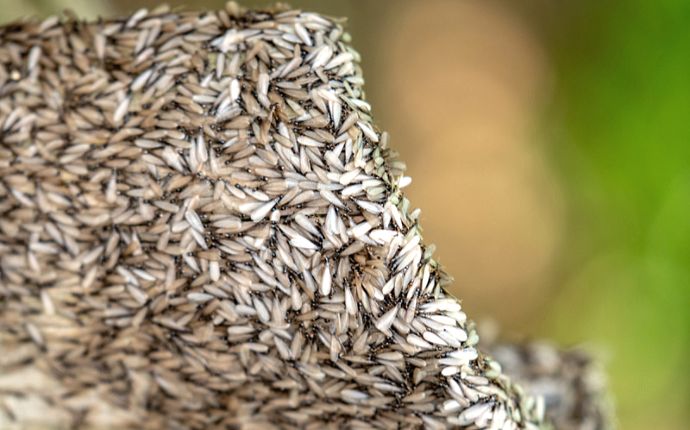Getting rid of termite swarmers is crucial because they indicate an established termite colony nearby, posing a serious threat to property. Prompt action can prevent costly structural damage.
Here’s how you can get rid of termite swarmers in your house.
- Moisture Control: Address water leaks and reduce moisture levels to discourage termite activity.
- Clear Debris: Remove your property’s wood debris like logs and dead trees.
- Vegetation Maintenance: Trim plants and keep them away from your home’s foundation.
- Bait Stations: Use termite bait stations to eradicate termite colonies effectively.
- Professional Help: Consult pest control experts for a thorough termite infestation assessment.
- Regular Inspections: Conduct routine termite inspections to catch infestations early.
How to Identify Termite Swarmers?

- Description of termite swarmers’ physical characteristics
Termite swarmers, also known as alates, are winged termites that emerge from mature termite colonies to start new colonies. They typically have the following physical characteristics:
Size: Termite swarmers are about 1/2 inch (1.27 cm) long, and their bodies are divided into three distinct segments: the head, thorax, and abdomen.
Color: They are usually light brown to black, with translucent wings that are twice the length of their bodies.
Antennae: Swarmers have straight antennae, as opposed to the bent antennae of ants.
- Differentiating termite swarmers from other insects
It’s essential to distinguish termite swarmers from other insects to take appropriate action. Here’s how to differentiate them:
Wing Length: Termite swarmers have wings that are equal in size and twice the length of their bodies. In contrast, ants have wings of different lengths.
Waist: Unlike ants, termite swarmers have a straight waist, while ants have a noticeable pinched or segmented waist.
Antennae: Termite swarmers have straight antennae, while ants have bent or elbowed antennae.
Behavior: Termite swarmers are attracted to light sources and are often found near windows or light fixtures. Ants, on the other hand, are more active on the ground.
Understanding Termite Swarmers Behavior
- Seasonal patterns and triggers for termite swarming
Termite swarmers follow distinct seasonal patterns and are triggered by specific conditions. Understanding these can help you take preventive measures:
Spring and Early Summer: Termite swarming is most common during these seasons when the weather is warm and humid.
Rainfall: Heavy rainfall can trigger swarming as it provides the moisture needed for the termites to survive.
Warm Temperatures: Termites are more active when temperatures rise, making spring and summer prime swarming times.
- Why swarmers are a potential threat to your property
Termite swarmers pose a significant threat to your property due to the following reasons:
Colony Establishment: Swarmers aim to establish new colonies, potentially leading to more extensive termite infestations in your home.
Wood Damage: Once a new colony is formed, the swarmers become workers who feed on wood and cellulose materials, causing structural damage.
Hidden Infestations: Termite swarmers often emerge indoors, indicating an existing infestation that may have been unnoticed.
- The role of swarmers in termite colony expansion
Termite swarmers play a vital role in expanding termite colonies:
Reproduction: Swarms are termite breeders aiming to start new colonies.
Queen Formation: Successful mating resulted in the development of new queens, which became the foundation of new termite colonies.
Workers and Soldiers: After establishing a colony, swarmers transform into workers and soldiers, sustaining and protecting the colony.
Understanding the behavior of termite swarmers, their seasonal patterns, and their role in colony expansion is essential for effective termite control and protecting your property from potential damage.
Termite Swarmers Prevention Methods
- Tips for reducing termite-friendly conditions around your property
To reduce the chances of termite problems and swarmer appearances, follow these steps:
Moisture Control: Fix leaks and ensure proper drainage to reduce excess moisture, as termites thrive in damp environments.
Wood Maintenance: Replace or repair damaged wood promptly, and store firewood and lumber away from your home’s foundation.
Landscaping: Maintain a clear space between soil and wooden structures, such as decks and siding.
Remove Dead Wood: Remove dead trees and stumps from your property to avoid attracting termites.
- Regular inspection and maintenance practices to deter termite infestations
Regular checks and upkeep are crucial for keeping termites away:
Annual Inspections: Schedule professional termite inspections to catch early signs of infestations.
Seal Entry Points: Seal cracks, crevices, and gaps in your home’s foundation to prevent termite entry.
Ventilation: Ensure proper ventilation in crawl spaces to reduce humidity and discourage termite activity.
Gutters and Downspouts: Clean gutters to move water away from your home’s foundation.
- Use Physical barriers and repellents to keep swarmers away
Implement physical barriers and repellents to deter swarmers and termites from your property:
Termite Screens: Install termite screens on doors and windows to prevent swarmers from entering your home.
Chemical Barriers: Consider soil treatments with termiticides, applied by professionals, to create a protective barrier.
Repellent Mulch: Use mulch made from materials like cypress or heartwood, which are less attractive to termites.
Nematodes: Beneficial nematodes can be used in your yard to prey on termite larvae.
Prevention Methods for Termite Swarmers
To protect your property from termite swarmers, consider the following preventive measures:
A. Steps to identify and locate termite swarms on your property
Observation: Keep a close watch for flying insects with straight antennae, equal-length wings, and a brown or black coloration.
Wings: Search for discarded wings near windows, lights, or on the ground, which may indicate recent swarming activity.
Wood Inspection: Check for hollow-sounding or damaged wood, especially in moisture-prone areas.
- Natural remedies and home-based solutions for swarmers eradication
If you’ve identified termite swarms, you can try these natural remedies and home-based solutions:
Beneficial Nematodes: Apply beneficial nematodes to your soil to target termite larvae and help control the termite population.
Cardboard Traps: Create simple traps by wetting pieces of cardboard and placing them near termite activity. Once termites infest the cardboard, remove and dispose of it.
Diatomaceous Earth: Sprinkle food-grade diatomaceous earth around affected areas. This natural powder can damage termite exoskeletons, leading to their demise.
Boric Acid Solution: Mix boric acid with water to create a termite-killing solution. Apply it to wooden surfaces or areas with termite activity.
- Safety precautions and limitations for DIY treatments
While DIY methods can be helpful, they come with safety considerations and limitations:
Chemical Safety: Handle any chemicals, such as boric acid, with care, following the manufacturer’s instructions and keeping them out of reach of children and pets.
Professional Assessment: DIY treatments may be less effective than professional pest control. If you suspect a severe infestation or have safety concerns, consult a pest control expert for a thorough assessment and treatment plan.
Regular Monitoring: Even after DIY treatments, monitor your property regularly for signs of termite activity to ensure that the infestation has been adequately addressed.
Factors to Consider When Choosing a Reputable Termite Control Company
When you’re looking to tackle termite swarmers, picking the right termite control company is essential. Here are some straightforward but vital factors to consider:
License and Certification: Ensure the company is licensed and certified to operate in your area. This is a fundamental requirement to ensure they meet the necessary standards.
Experience Matters: Opt for a company with a solid history in termite control. Experience counts when it comes to handling swarmers and addressing termite infestations effectively.
Insurance Coverage: Check if the company has liability insurance. This insurance can cover any potential damage that might occur during the termite treatment process, offering you peace of mind.
Client References: Don’t hesitate to ask for references from past clients. Talking to people who have used the company’s services can give you valuable insights into their reliability and performance.
Treatment Methods: Inquire about the methods the company uses for termite control. Ensure they use safe and effective treatment options that are also considerate of your family and pets.
Cost Transparency: Seek detailed cost estimates upfront. Make sure you fully understand what you’re paying for and if there are any ongoing costs or maintenance requirements.
Warranty or Guarantee: Inquire about the company’s warranties or guarantees. A trustworthy company should back their work and offer confidence in their services.
Professionalism: Pay attention to their professionalism. This includes punctuality, communication, and how well they address your questions and concerns.
Online Reviews: Take a moment to check online reviews and ratings of the pest control service. The customer reviews can help you understand how better service they provide to their customers.
Long-Term Termite Swarmer Prevention Strategies

To maintain a termite-free home in the long run, follow these practical and effective prevention strategies:
A. Maintenance practices to prevent future termite swarmer infestations
Regular Inspections: Schedule annual inspections by a professional pest control expert. These proactive assessments can catch termite activity before it becomes a major issue.
Seal Entry Points: Continuously inspect your home for gaps, cracks, and crevices in the foundation, and promptly seal them to keep termites out.
Wood Maintenance: Repair or replace damaged wood promptly to eliminate potential food sources. Keep firewood, lumber, and cellulose materials away from your home’s foundation.
Moisture Control: Address any leaks and ensure proper drainage to minimize excess moisture, which termites thrive in. Promptly fix plumbing or roof issues.
Landscaping: Maintain a gap between soil and wooden structures like decks and siding. Avoid using wood mulch near your home, as it can attract termites.
B. Regular monitoring and early detection techniques
Termite Bait Stations: Install termite bait stations around your property. These serve as monitoring devices and can provide an early warning if termites return.
Visual Inspections: Regularly check for termite signs like mud tubes, discarded wings, or damaged wood on your property.
Professional Assessments: Continue to engage pest control professionals for annual or biannual inspections. Their expertise can uncover any signs of termite swarmers or infestations.
C. Sustainable practices for termite-free homes
Use Termite-Resistant Materials:
When building or renovating, think about using termite-resistant materials like treated wood or steel framing.
Natural Barriers: Incorporate natural barriers like rocks or gravel around your foundation to discourage termites from approaching.
Proper Storage: Elevate items such as firewood, cardboard boxes, and lumber off the ground and away from your home.
Reduce Soil Contact: Minimize soil-to-wood contact around your property. This includes ensuring that soil levels remain below the wooden parts of your home.
FAQs
What are termite swarmers?
Termite swarmers are winged adult termites that leave the colony to establish new ones. They are often a sign of a nearby termite infestation.
How do I identify termite swarmers?
Termite swarmers have two pairs of equal-sized wings and straight antennae, unlike ants with bent antennae and different-sized wings.
Can I eliminate termite swarmers on my own?
While you can try to eliminate visible swarmers with a vacuum cleaner, addressing the underlying termite colony with professional help is essential.
What attracts termite swarmers to my home?
Moisture, decaying wood, and cellulose materials are common attractants. Reducing these conditions can help deter them.
How can I prevent termite swarmers in the first place?
Keep your home well-ventilated, fix leaks promptly, and schedule regular termite inspections.
Do termite swarmers cause damage on their own?
No, termite swarmers do not cause structural damage on their own. Their presence indicates a nearby termite colony that can cause damage.
Are termite swarmers harmful to humans or pets?
Termite swarmers are not harmful to humans or pets. They do not bite, sting, or transmit diseases.
What does a termite treatment plan involve?
A professional treatment plan typically includes identifying the termite species, assessing the extent of the infestation, and implementing effective control methods.
How long does it take to get rid of termite swarmers and the colony?
It can take approximately 3 to 12 months to get rid of termite swarmers and their colony completely, depending on factors like the size of the colony and the chosen treatment method.
Conclusion
To sum up, eliminating termite swarmers involves both prevention and specific treatments.
If an infestation is already present, professional assistance should be sought, as they can provide effective treatments such as baiting systems or liquid termiticides tailored to the specific situation.
Taking prompt action and implementing preventative measures can help homeowners effectively eliminate termite swarmers and protect their property from structural damage.

